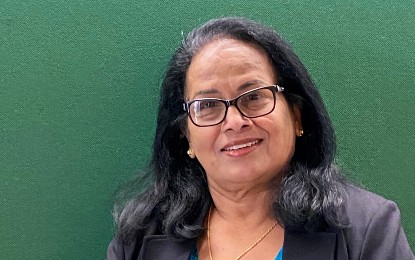Osteoporosis, a condition that’s defined by a loss of bone density that makes a person more susceptible to fractures and can be life-threatening, affects millions worldwide. In the United States, about one in 10 people age 50 and older have been diagnosed, and another 44 million people are estimated to have the disease or are at risk.

Meenakshi Chellaiah, PhD, focuses on bone remodeling caused by changes in osteoclasts and osteoblasts in response to various treatments and cancer metastasis to bone.
The condition has been dubbed a silent disease because its symptoms don’t often present early. But its impact, such as when a senior person falls and suffers a broken hip, can lead to death.
Medications and lifestyle changes are the predominant means of treatment while health care professionals explore novel avenues for preventing bone loss. That’s the leading scientific focus for Meenakshi Chellaiah, PhD, a professor in the Department of Oncology and Diagnostic Sciences at the University of Maryland School of Dentistry (UMSOD). Chellaiah focuses on bone remodeling caused by changes in osteoclasts and osteoblasts in response to various treatments and cancer metastasis to bone.
"Bone is a living tissue renewed constantly throughout life," she says. Osteoclasts remove older bones, and new bones are formed by osteoblasts. When the balance is off, osteoporosis results.
In November 2022, Chellaiah was awarded a patent for a small peptide drug that is non-toxic and clears the system quickly, minimizing long- and short-term side effects, and this could add to the arsenal of ways to treat or, better yet, prevent or slow the progression of the disease.
“Osteoporosis is the most common bone disease in the world and usually results from aging and chronic inflammation,” Chellaiah says. “Those with the condition have bones that become increasingly brittle, putting them at higher risk for fractures and breaks. Falls present a particular risk, and sometimes something as simple as coughing, sneezing, and twisting the body can lead to a painful outcome.”
The condition presents most often in older women of Caucasian and Asian descent. However, men can be affected. The most affected sites for fractures are the wrist, spine, and hip. Symptoms include back pain, becoming shorter or stooped, and unexpected fractures from simple activities.
Osteoporosis is a Latin term that means porous bones, Chellaiah says. Bone density tests with X-rays measure calcium and other minerals to diagnose the disease. Most frustrating to patients is how it affects their independence and ability to be active without worrying about the consequences. It’s also painful and debilitating.
Chellaiah, who has been affiliated with UMSOD since 2000, took an interest in her current peptide research after attending several conferences that spotlighted how Fosamax — the standard drug used to treat osteoporosis for the past 50 years — came with serious side effects that include osteonecrosis of the jaw and atypical femoral fractures. In addition, this drug can be taken orally for three to five years (about three years if administered intravenously), then must be halted.
This peptide has shown promising results in mice. The benefits are that it’s a simple amino acid, clears quickly from the body, is affordable, and is scalable to meet patient needs. In the mice tested, the peptide showed the remarkable capability to reduce bone loss by decreasing osteoclasts’ activity without affecting the osteoblasts’ ability to build bone strength.
“It’s like hitting two birds with one stone,” Chellaiah says.
Her next steps include using nanotechnology to improve efficacy by sustaining the release of the peptide to specific areas of interest within the body without frequent injections. And, she adds, this peptide also shows potential for treating other inflammatory conditions, including arthritis and periodontitis.
“I’m excited about the results we’ve seen so far and the potential it has to improve the lives of so many,” Chellaiah says.



